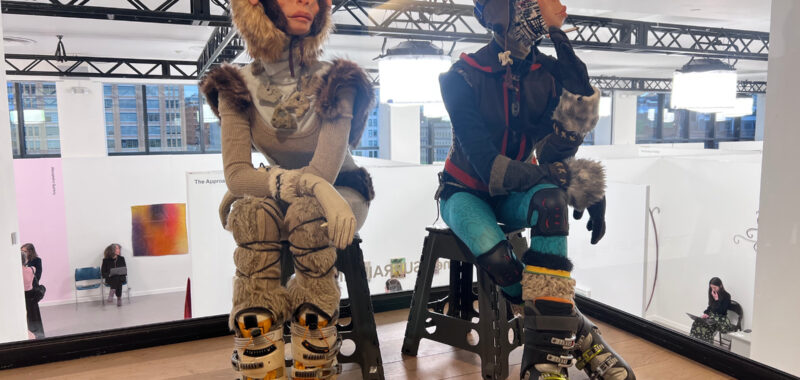My first stop at the Independent Art Fair was the rooftop bar: I wanted to catch my breath, enjoy the view, eavesdrop a little. I was immediately rewarded (though not with a drink — if the public opening is anything like the private preview, the line is simply not worth your time). Two blandly stylish early-20-year-olds were sitting at the patio were discussing the view: “Oh, it’s giving,” one of them waved their hand vaguely at the storm clouds roiling at the horizon, “It’s giving New York.”
Such can be the feeling of trying to differentiate between the many New York art fairs this week — Frieze, NADA, Esther II, Future, ad infinitum. They all have well-lit white booths lined with art, presided over by beleaguered gallerists sipping on cocktails, just trying to make it through the day. The Independent, which opens to the public today, May 9, and runs through this Sunday, May 11, is celebrating its sweet 16. What started out as a more boutique experience has wizened into more traditional fare (no pun intended). With 85 galleries — the most in the fair’s history — the booths are sandwiched together with less breathing room within and between, though it still doesn’t quite have the purgatorial feel of some others, with lines of booths stretching past the limit of your sight. The artspeak on the fair’s website does little to establish its difference: “Meaning and context are everything,” it declares, a statement with neither meaning nor context.

Still, the Independent has some distinguishing features. Almost half of the 85 galleries at this year’s edition — 39, to be precise — are making their debut, and 26 new artists are being shown. It intends to be “non-hierarchical,” as founding curatorial advisor Matthew Higgs put it to me, and largely succeeds: There’s no “Focus” or “Discovery” sections, which platform younger-up-and-coming artists and spaces, as in Frieze or Art Basel. Decades-old galleries like Jane Lombard, Yancey Richardson, Mitchell-Innes & Nash, and, of course, White Columns, where Higgs is director, share elbow room with spaces that opened in the last few years, like Fair Warning, Management, and Margot Samel. In terms of the crowd, I’d say it’s about 15 years younger than Frieze, and about as White. (If you’re here for the designer-dog-watching, though, let’s just say this might be the promised land.)
Take this market statement from this reviews-editor-at-heart with a grain of salt: I think it’s got the highest standard of work of the fairs I’ve attended.

The Independent is invite-only, and co-founders Higgs and Elizabeth Dee clearly had a directive in mind. A lot of downtown stalwarts are showing, including March, Off Paradise, and Magenta Plains, as well as galleries that just moved to Tribeca, such as YveYang, Swivel, and the Hole galleries. It’s in line with a larger shift in the art world toward Tribeca — Jane Lombard moved there from Chelsea in 2020, and Mitchell-Inness just shuttered their Chelsea space to move toward a “project-based advisory” model. Well-known galleries from other cities — Daniel Faria from Toronto, Corbett vs. Dempsey and Monique Meloche from Chicago, and Voloshyn from Kyiv as a small sample — are also present.
Shrine — also new to Tribeca — has previously shown at NADA. With a budget of one fair a year, they chose the Independent. Stenciled into the top of its booth was the name “Laura Footes”; below, however, was the work of six self-taught artists, including Bill Traylor. Footes’s work had been caught up in customs due to the Trump administration’s recent tariffs, and had been stuck at JFK Airport until just earlier that day. “Something we had anticipated would take a week took two and a half weeks,” gallerist Tess Reichlen told me, mentioning that the customs process had impacted one other gallery at the fair.
On that topic, I heard rumor of artwork being carried in by suitcase, which did occur at Esther II, but was unable to quite confirm that to be the case here. “I was totally kidding about the suitcases, by the way,” an unnamed source told me, “and I’m also not going to mention what gallery I work at.”


Still, the artwork that found its way here is strong. Artworld favorites like Pope.L, Wolfgang Tillmans, and Tseng Kwong Chi hold forth. In terms of semi-realist painting, I was partial to the intimate vignettes of Claudia Keep at March gallery, the haunted figures of Satoru Kurata at Tomio Koyama, and the quiet still lives of Zoë Carlon at South Parade. I discovered new-to-me names that I’ll be keeping my eye on, as in Shanna Waddell’s figurative ceramics at Vielmetter, Achraf Touloubs’s striated crowd scenes at Parliament, and Ada Friedman’s mixed media semi-abstractions and Constanza Kramer Garfias’s scrawled tapestries at Kendra Jayne Patrick gallery. I also liked Huidi Xiang’s matte-black punctured tomato sculptures, which are both playful and bittersweet (a visitor did step on one, the artist confided, but it’s good-as-new).
At the end of the day, it’s all about the art, and the Independent’s a good time, even for art-world newbies: “I like how approachable it feels,” first-time “big-fair” attendee Joe Tessler told me. “Every booth has a representative who’s willing to talk to you. It has an intimate feel.”













